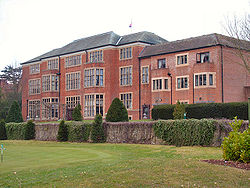Hanbury Manor
| Hanbury Manor | |
| Hertfordshire | |
|---|---|
 Hanbury Manor | |
| Location | |
| Grid reference: | TL35121629 |
| Location: | 51°49’44"N, 0°2’26"W |
| History | |
| Built 1890–91 | |
| For: | Edmund Smith Hanbury by Ernest George and Harold Peto |
| Country house | |
| Neo-Jacobean | |
| Information | |
| Condition: | Converted to a hotel |
| Owned by: | Marriott Hotels |
Hanbury Manor is a late-Victorian country house which has been converted into a hotel, the Hanbury Manor Hotel, with an adjoining golf course. It is found in Thundridge, north of Ware, Hertfordshire.
The house was built in the nineteenth century for the Hanbury family, replacing a much earlier manor house, known as 'Poles' from its former ownership. The is a Grade II* listed building under the name 'Poles Convent'.[1]
The hotel is part of a leisure retreat and country club owned by Marriott Hotels.
History
Reginald Pole (1500-1558)
A grand house stood on the site of the current house in the 16th century. The land belonged to Reginald Pole, whose mother, Margaret Pole, 8th Countess of Salisbury, was the last legitimate heir of the Plantagenet royal house based on strict patrilineality before the House of Tudor. Reginald Pole was appointed a cardinal before Henry VIII renounced the authority of Rome, and after the brief restoration of the Roman Church under Queen Mary I he served for two years as her Archbishop of Canterbury. He died 12 hours after the Queen. From his ownership of the estate, it was known as 'Poles'.
Hanbury family
During the final years of the 18th century the Hanbury family chose to settle here, first becoming lessees,[2] but then Sampson Hanbury bought Poles outright about the year 1800. From 1799 to 1830 he was Master of the Puckeridge Hounds. Childless, he left Poles to his widow, Agatha.[2]
Robert Hanbury, a senior partner in the Truman, Hanbury, Buxton & Co brewery, inherited Poles on the death of his aunt Agatha in 1847. His son, also Robert Hanbury, who served as one of the Members of Parliament for Middlesex, died before inheriting, and the estate was inherited by his son, Edmund Smith Hanbury (1850–1913), who brought his family to live at Poles,[3] At the time, the estate extended to more than 2,000 acres. His wife, Amy, however found the house to be a rambling, uninhabitable monstrosity and refused to live in it. Edmund therefore determined to replace the old house.
Architects Sir Ernest George and Harold Peto designed a replacement grand house,[4] built for Hanbury by Simpsons & Ayrton of Paddington in 1890–91 for £20,000. The final cost, £30,000, may well have hastened the end of the great prosperity of his branch of the family. The house, built in the Jacobean style in red brick with blue brick reticulation and stone mullioned windows, was the first in the parish to have electricity and to have a central heating system.[1]
A service wing and stables were added in 1913, by which time the estate had shrunk to 100 acres.[3]
Edmund's only son, Robert Francis Hanbury, a barrister, sold Poles in 1914 to Mr H J King.[2]
Poles Convent
In 1923 the house was purchased by a Roman Catholic trust, known as the Faithful Companions of Jesus, with the intent of establishing a convent school.[4] The house was transformed in 1934 with the addition of a gym, classrooms, dormitories, a three-storeyed tower, and a new chapel. From 1974, girls from the convent school progressed into the sixth form of St Edmund's College, Ware. By the time the school closed in 1986, St Edmund's College was fully co-educational.[5]
Hotel
The estate was redeveloped and extended over a three-year period by Landbase Ltd as a 5-star hotel and country club, opening in 1990. The development was majority funded by local building firm Hubert C Leach.
The former parts of the main building whilst a convent school having been a gym, chapel and classrooms, formed the base for a conference and banqueting centre set around the courtyard. The latter-day chapel, renamed Poles Hall, forms the main banqueting hall. The development in 1988/89 added a wing onto the main building containing swimming pool, gym, changing rooms, squash courts, bar, brasserie restaurant, and billiard room. An annexe next to the walled garden (known as the Garden Court) added 53 bedrooms at the same time.
The next later owner, Marriott International, added a 65-bedroom extension in 1999. Marriott also own and operate the neighbouring golf course.
The Hanbury Manor golf course was first designed by Harry Vardon in the early 1900s as a 9-hole course, and the newer (1991) 18-hole course by Jack Nicklaus II.[6] The course hosted the Marks & Spencer European Open in 1996 and the English Open from 1997 to 1999.
Outside links
| ("Wikimedia Commons" has material about Hanbury Manor) |
References
- ↑ 1.0 1.1 National Heritage List 1204101: Poles Convent
- ↑ 2.0 2.1 2.2 Hanbury, Jillian (15 July 2007). "The Hanburys of England". Antony Maitland. http://www.antonymaitland.com/hanbry01.htm. Retrieved 29 March 2010.
- ↑ 3.0 3.1 A History of the County of Hertford - Volume 3 pp 377–380: {{{2}}} (Victoria County History) – [1]
- ↑ 4.0 4.1 "Hanbury Manor Formerly Poles Convent School". Herts Memories. http://www.hertsmemories.org.uk/page_id__1713_path__0p34p128p.aspx. Retrieved 4 June 2014.
- ↑ Parliamentary Debates, House of Commons of the United Kingdom, 8 January 1990 , column 477
- ↑ "Hanbury Manor Golf & CC". top100golfcourses.co.uk. http://www.top100golfcourses.co.uk/htmlsite/productdetails.asp?id=42. Retrieved 26 March 2010.
